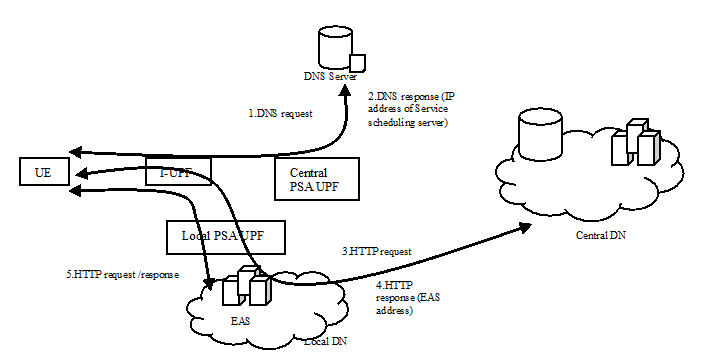Content for TS 23.548 Word version: 19.1.0
1…
4…
4.3
5…
6…
6.2.2.3…
6.2.3…
6.2.3.2.3…
6.2.3.2.5…
6.2.3.3…
6.3…
6.4…
6.5…
6.6
6.7…
6.7.2.4…
6.7.2.6…
6.7.3…
6.8…
6.10…
7…
A
B…
F…
A EAS Discovery Using 3rd Party Mechanisms p. 82
There are different IP discovery mechanisms existing in the application layer. For example, the application client can generate the DNS Query outside of DNS libraries in the OS with DoT, DoH or other over the top mechanisms.
The third party can also deploy a service scheduling server to determine the (E)AS IP address based on the UE's HTTP(S) request. In this case, the DNS firstly resolves the FQDN in the DNS Query of the UE into the IP address of the service scheduling server and then the UE contacts the service scheduling server that can provide the IP address of the EAS that the UE is then to contact.
For the Distributed Anchor Point connectivity model, in order to enable EAS discovery by third party mechanisms, the DNS Server or service scheduling server in the third party could be pre-configured with mapping information between the IP address range which can correspond to the Central PSA UPF or other entities (e.g. a NAT server) on the N6 interface and EAS information. In this case, the DNS Server or service scheduling server in the third party can take the source IP address of the UE request as the location information of UE. The DNS and/or service scheduling server pre-configuration can be based on the agreement between the MNO and service provider.
For the Session Breakout connectivity model, based on agreement with the operator, a possible solution for the service scheduling server is as follows:
- The IP address of the service scheduling server can be set as a condition in the ULCL UPF to offload traffic. The IP address of service scheduling server can be pre-configured or resolved by the EASDF based on procedure defined in clause 6.2.2.2.
- NAT server can be deployed in the L- DN or local N6 interface, in order that the source IP address of the UE request sent to the service scheduling server can correspond to the UE location related information.
